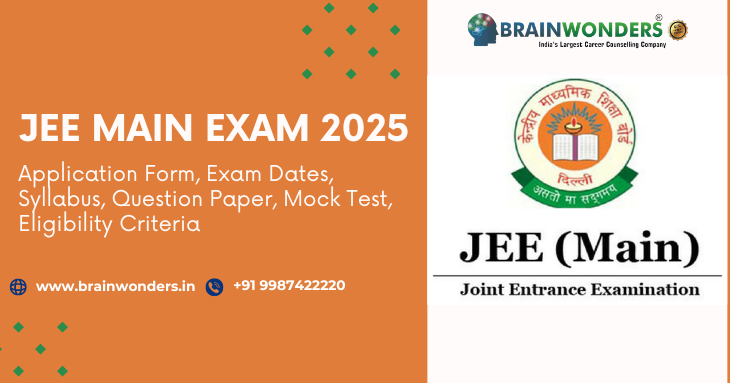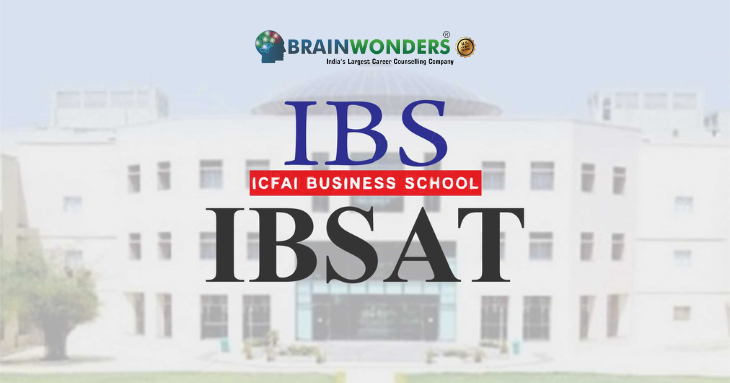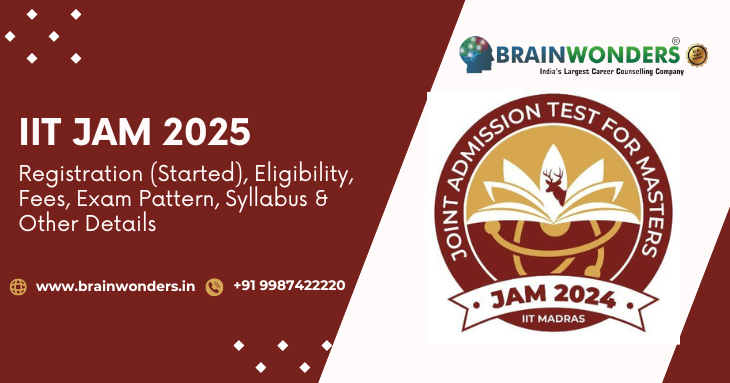

Take Brainwonders Career Test and make the right decisions for your college and course ahead
Get your U.S. Patented DMIT analysis and lead the way to a happy and successful career
Blog
20 September,2024 | By Brainwonders

National Testing Agency (NTA). The JEE Main exam 2025 will be held provisionally in January and April twice a year. The actual date for JEE Main 2025 for sessions 1 and 2 has yet to be announced on the official website - jeemain.nta.ac.in. JEE Main Application Form 2025 will be released in November, and students are required to fill application online on the JEE Main Website.
To qualify for the JEE Main test, a candidate must be sitting or has sat for pre-University or equivalent examination and must have offered Physics, Chemistry, and Mathematics as major subjects. There is no age limit or minimum score requirement in Class 12 to sit for the exam; however, candidates can attempt it for up to three consecutive years following their Class 12 completion. Detailed eligibility criteria for JEE Main 2025 can be found on this page.
The exam will primarily be computer-based, except for the Drawing section of Paper 2, which will be conducted using pen and paper. For effective preparation, candidates can refer to the JEE Main 2025 Syllabus PDF, exam pattern, and previous year's papers.
| Particulars | Details |
| Name of exam | Joint Entrance Examination (Main) or JEE Main |
| Conducting body | National Testing Agency |
| Level of exam | Undergraduate |
| Exam frequency | Twice a year in January and April |
| Mode of exam | Online as a computer-based test |
| How many students appear for JEE Main | Approx 10 lakh |
| Courses offered | BTech, BArch and BPlan |
| Application fees |
INR 1000 (Male unreserved/OBC/EWS category) INR 800 (Female unreserved/OBC/EWS category) INR 500 (SC/ST/PwD/Transgender category) |
| Exam duration |
3 hours 4 hours for PwD |
| Total marks |
300 marks for Paper-1 (BE/BTech) 400 marks for Paper-2A (BArch) 400 marks for Paper-2B (BPlan) |
| Marking scheme |
+4 for each correct response -1 for each incorrect response |
| Total Questions |
90 questions in Paper 1 (BE/BTech) 82 questions in Paper 2A (BArch) 105 questions in Paper 2B (BPlan) |
| Language of paper/exam | 13 languages- English, Hindi, Assamese, Bengali, Gujarati, Kannada, Marathi, Malayalam, Odia, Punjabi, Tamil, Telugu and Urdu |
| Accepting colleges | All NITs, IIITs and CFTIs |
Take a look at the table below for the complete schedule of JEE Main 2025 exam
| Dates | Upcoming Exam Dates |
| Nov '24 - Dec '24 | JEE Main 2025 Registration Session 1 |
| Jan '25 | JEE Main 2025 Exam Date Session 1 |
| Feb '25 | JEE Main 2025 Session 2 Registration |
| Apr '25 | JEE Main 2025 Exam Date Session 2 |
JEE Main, known as Joint Entrance Examination Main, is a national level access to admission in the first year of B Tech, B Arch & B Plan courses across various NITs, IIITs, CFTIs and other Institutions, specifically volume-wise recognized state technical universities/specialized university under Section 3 of UGC Act and participating Universities/ Institutions. Furthermore, it is an eligibility test for JEE Advanced, through which students get admission to IITs.
JEE Main is conducted twice a year, and therefore, it gives the students an opportunity to score better at least two times a year. There is no restriction regarding whether the candidates want to sit for only one attempt or both attempts available to them.
Education: To get admission to IIT, students have to qualify for JEE Main and must have got the criteria cutoff for the same. Aspirants appear for this examination every year, and lakhs of candidates try their luck; hence, they have to work hard.
NTA releases the application form for the exam in November. This form will be available online through the official website of JEE Main at www.jeemain.nta.ac.in.
New application forms will be required for the January and April intakes. Students can also fill out the form for both sessions together.
Applicants are required to attach scanned image of their passport size photograph as well as their signature while filing the application.
SC/ST/OBC-NCL/PwD Or Gen-EWS category certificates also have to be uploaded for the applicant when applying for the post.
The JEE Main 2025 application process involves several stages:
Candidates applying for JEE Main 2025 should have the following documents ready:
| Category | Fees |
| Male candidates of Unreserved/ EWS/OBC category |
For Centres in India - INR 1,000 For Centres Outside India - INR 5,000 |
| Female candidates in the Unreserved/EWS/OBC category |
For Centres in India - INR 800 For Centres Outside India - 4,000 |
| SC/ST/PwD/Transgender category candidates |
For Centres in India - INR 500 For Centres Outside India - 2,500 |
JEE Main is one the toughest exams out there and one needs to plan the preparation strategy before attempting it. That is the reason why many students prepare for years and study hard to succeed and get a good result on the JEE Main 2025. More than 10 lakh students appear in this examination for taking admission in the premier engineering institutes like IITs, NITs and other technical colleges. Here are some essential preparation tips to help candidates perform better in the exam:
| Physics Important Chapters for JEE Mains | Mathematics High Weightage Chapters for JEE Mains | Chemistry Important Chapters |
|
|
|
Follow these steps to complete the JEE Main 2025 application process:
After submission, candidates will receive an acknowledgement slip via email and SMS containing details about their application form. It is essential to download and save this form for future reference.
NTA will provide the option for the candidates to edit the details they filled in within the application form of JEE Main. This correction window will be available after every application submission. The correct link to fill or make the correction of the JEE Main 2025 application form will be available at jeemain.nta.ac.Candidates who have successfully filed the application and want to make changes would be able to do so on the JEE Main 2025 official site. Let it also be recalled that only selected fields, including the field for the category, address, photo, etc., will be made editable during this period.
To edit the application form, follow these steps:
Here are the eligibility criteria for JEE Main as set by the NTA. Candidates should ensure they meet these requirements before applying for the exam, as failing to do so may result in disqualification.
The JEE Main admit card 2025 will be released by the National Testing Agency (NTA) online on the authorized website of the JEE Main exam jeemain.nta.ac.in a couple of days before the examination takes place. A hyperlink to download the JEE Main 2025 admit card shall also be provided on this page. The admit card will bear information about the date and time for the test, venue address, roll number, candidate’s name, signature, photograph and other important instructions for the day of the examination.
The candidates need to download the admit card for the JEE Main 2025 examination after checking the details to determine the correctness of the information provided. Circumstances may arise when some differences or mismatches are found, and in such a situation, it is recommended that the authorities of the exams be contacted. Candidates must also produce original identity cards with photographs to the examination hall apart from the admit card. Additionally, it is important to download and print the admit card for safekeeping.
Within a few days of conducting the JEE Main 2025 examination, NTA will upload the official answer key on its web portal. To access the JEE Main answer key, the candidates will have to use their application number combined with their date of birth. The answer sheet will provide the correct choice for every question given in the examination.
First, the provisional answer key will be issued. The candidates who are not content with any of the answers in the provisional key can only raise an objection to it online in the said period. After NTA has reviewed all the grievances, the final answer key will be released out.
Steps to download the JEE Main Answer Key 2025:
As has been tradition, the JEE Main 2025 result shall be released a week following the test. The JEE Main scorecard can also be accessed online through the official portal of NTA – jeemain.nta.ac.in The candidate will have to use their application number and date of birth to log into the portal to get the scorecard of JEE Main.
The JEE Main 2025 result will consist of percentile information in science, mathematics, and English, besides the overall aggregate percentile.
Steps to check the JEE Main Result 2025:
The JEE Main cutoff is the minimum percentile score required for candidates to qualify for JEE Advanced. Each category has its unique cutoff, as shown below. The.The JEE Main cutoff for 2024 has been provided along with the previous years’ cutoffs, namely, the JEE Main 2023 cutoff for the SC/ST category, the JEE Main 2022 and the JEE Main 2021 cutoff.
It's important to note that there is no minimum passing score required for the JEE Main exam. The All India Rank (AIR), determined by the candidate's JEE Main score, is used for admission to NITs, IIITs, and GFTIs. The JEE Main cutoff is solely for those wishing to appear in JEE Advanced.
The NTA has made the official JEE Mains 2025 mock tests available for free on its website, nta.nic.in.The specific intended audience for this publication is students who plan to take the standardized test, A either complete or partially to find and practice these mock tests on the internet for free. The mock tests available on the NTA portal are as close to the actual JEE Main examination and help a candidate get a realistic picture of himself for the examination.
Here are the steps to take the JEE Main 2025 mock test online via the NTA website:
| Category | Cutoff 2024 |
| Unreserved (UR) | 100.0000000 to 93.2362181 |
| OBC-NCL | 93.2312696 to 79.6757881 |
| SC | 93.2312696 to 60.0923182 |
| ST | 93.2312696 to 46.6975840 |
| UR-PwD | 93.2041331 to 0.0018700 |
| Category/Year | 2023 | 2022 | 2021 |
| General | 90.7788642 | 88.4121383 | 87.8992241 |
| OBC-NCL | 75.6229025 | 67.0090297 | 68.0234447 |
| SC | 73.6114227 | 43.0820954 | 46.8825338 |
| ST | 51.9776027 | 26.7771328 | 34.6728999 |
| Gen-EWS | 37.2348772 | 63.1114141 | 66.2214845 |
| PwD | 0.0013527 | 0.0031029 | 0.0096375 |
The JEE Main 2025 exam will consist of three papers: Paper 1, Paper 2A, and Paper 2B. Candidates interested in pursuing BE/BTech should attempt Paper 1. Paper 2A is designated for those applying for the BArch program, while Paper 2B is for candidates aiming for the BPlanning course. The detailed exam pattern for each of these papers in JEE Main 2025 is outlined below.
| Particulars | Details |
| Mode of exam | Online (Computer-Based Test) |
| Subjects Covered | Physics, Chemistry and Mathematics |
| Type of questions |
Multiple Choice Questions (MCQ) Numerical Value Answer (NAV) type questions |
| Total number of questions | 90 Questions |
| Total duration of exam | 3 hours |
| Subject-wise number of questions |
Physics- 20 MCQ and 10 Numerical Value Questions Chemistry- 20 MCQ and 10 Numerical Value Questions Mathematics- 20 MCQ and 10 Numerical Value Questions |
| Marking scheme |
4 Mark for the correct answer 1 Mark deducted for an incorrect answer |
| Language of paper | Total 13 languages (Assamese, Bengali, Kannada, Malayalam, Marathi, Odia, Punjabi, Tamil, Telugu, and Urdu in addition to Hindi, English, and Gujarati) |
| Particulars | Details |
| Mode of exam | Online (Computer-based test) except drawing section |
| Subjects Covered |
Mathematics General Aptitude Drawing |
| Type of questions |
Multiple choice questions (MCQ) Numerical value answer (NAV) type questions Drawing question |
| Total number of questions | 82 |
| Total duration of exam | 3 hours |
| Subject-wise number of questions |
Mathematics- 20 MCQ and 10 NAV General Aptitude- 50 MCQ Drawing- 2 questions on drawing |
| Marking scheme |
4 Mark for the correct answer 1 Mark deducted for an incorrect answer |
| Language of paper | Total 13 languages (Assamese, Bengali, Kannada, Malayalam, Marathi, Odia, Punjabi, Tamil, Telugu, and Urdu in addition to Hindi, English, and Gujarati) |
| Particulars | Details |
| Mode of exam | Online (Computer-based test) |
| Subjects Covered | Mathematics, General Aptitude and Planning |
| Type of questions |
Multiple choice questions (MCQ) and Numerical Value Questions (NAV) in Mathematics Multiple choice questions (MCQ) in General Aptitude and Planning |
| Total number of questions | 105 |
| Total duration of exam | 3 hours |
| Subject-wise number of questions |
Mathematics- 30 General Aptitude- 50 Planning- 25 |
| Marking scheme |
4 marks for every correct answer 1 marks deducted for every incorrect answer |
| Language of paper | Total 13 languages (Assamese, Bengali, Kannada, Malayalam, Marathi, Odia, Punjabi, Tamil, Telugu, and Urdu in addition to Hindi, English, and Gujarati) |
| Mathematics | Physics | Chemistry |
| Sets, Relations, and Functions | Physics and Measurement | Some Basic Concepts in Chemistry |
| Complex Numbers and Quadratic Equations | Kinematics | Atomic Structure |
| Matrices and Determinants | Laws of Motion | Chemical Bonding and Molecular Structure |
| Permutation and Combination | Work, Energy and Power | Chemical Thermodynamics |
| Trigonometry | Rotational Motion | Solutions |
| Binomial Theorem and its Simple Applications | Gravitation | Equilibrium |
| Sequence and Series | Properties of Solids and Liquids | Redox Reactions and Electrochemistry |
| Limit, Continuity, and Differentiability | Thermodynamics | Chemical Kinetics |
| Integral Calculus | Kinetic Theory of Gases | Classification of Elements and Periodicity in Properties |
| Differential Equations | Oscillation and Waves | p-block elements |
| Co-ordinate Geometry | Electrostatics | d- and f-block elements |
| Three Dimensional Geometry | Current Electricity | Coordination Compounds |
| Vector Algebra | Magnetic Effect of Current and Magnetism | Purification and Characterization of Organic Compounds |
| Statistics and Probability | Electromagnetic Induction and Alternating Current | Some Basic Principles of Organic Chemistry |
| Electromagnetic Waves | Organic Compounds containing Halogen | |
| Optics | Organic Compounds containing Oxygen | |
| Dual Nature of Matter and Radiation | Organic Compounds containing Nitrogen | |
| Atoms and Nuclei | Biomolecules | |
| Electronic Devices | Chemistry in Everyday Life | |
| Principles Related to Practical Chemistry |
| Subjects | Topics |
| Mathematics | Sets, Relations and Functions, Complex Numbers and Quadratic Equations, Matrices and Determinants, Permutations and Combinations, Mathematical Inductions, Binomial Theorem and its Simple Applications, Sequence and Series, Limits, Continuity and Differentiability, Integral Calculus, Differential Equations, Coordinate Geometry, Three-dimensional Geometry, Vector Algebra, Statistics and Probability, Trigonometry, Mathematical Reasoning |
| General Aptitude | Awareness of persons, Buildings, and Materials: Objects, Texture related to Architecture and Build-envirounmentVisusalising three-dimensional objects from two-dimensional drawings. Visualizing. Different sides of three-dimensional objects. Analytical Reasoning Mental Ability (Visual. Numerical and Verbal) Three-dimensional- perception: Understanding and appreciation of scale and proportions of objects, building forms and elements, colour texture harmony and contrast Design and drawing of geometrical or abstract shapes and patterns in pencil. Transformation of forms both 2D and 3D union, subtraction rotation, development of surfaces and volumes, Generation of Plan, elevations and 3D views of objects, Creating two-dimensional and three-dimensional compositions using given shapes and forms. |
| Drawing | Sketching of scenes and activities from memory of urbanscape (public space, market, festivals, street scenes, monuments, recreational spaces, etc), landscape (riverfronts. Jungle. Gardens, trees. Plants, etc.) and rural life. |
| Subjects | Topics |
| Mathematics | Sets, Relations and Functions, Complex Numbers and Quadratic Equations, Matrices and Determinants, Permutations and Combinations, Mathematical Inductions, Binomial Theorem and its Simple Applications, Sequence and Series, Limits, Continuity and Differentiability, Integral Calculus, Differential Equations, Coordinate Geometry, Three-dimensional Geometry, Vector Algebra, Statistics and Probability, Trigonometry, Mathematical Reasoning |
| General Aptitude | Awareness of persons, Buildings, and Materials: Objects, Textures related to Architecture and building environment Visualising three-dimensional objects from two-dimensional drawings. Visualizing. Different sides of three-dimensional objects. Analytical Reasoning Mental Ability (Visual. Numerical and Verbal) Three-dimensional- perception: Understanding and appreciation of scale and proportions of objects, building forms and elements, colour texture harmony and contrast Design and drawing of geometrical or abstract shapes and patterns in pencil. Transformation of forms both 2D and 3D union, subtraction rotation, development of surfaces and volumes, Generation of plans, elevations and 3D views of objects, Creating two-dimensional and three-dimensional compositions using given shapes and forms. |
| Planning | General Awareness: General knowledge questions and knowledge about prominent cities, development issues, government programs, etc. Social Science: The idea of nationalism, nationalism in India, pre-modern world, 19th-century global economy, colonialism, and colonial cities, industrialization, resources, and development, types of resources, agriculture, water, mineral resources, industries, national economy; Human Settlements Power-sharing, federalism, political parties, democracy, the constitution of India Economic development- economic sectors, globalization, the concept of development, poverty; Population structure, social exclusion, and inequality, urbanization, rural development, colonial cities, Thinking Skills: Comprehension (unseen passage); map reading skills, scale, distance, direction, area, etc.; critical reasoning; understanding of charts, graphs, and tables; basic concepts of statistics and quantitative reasoning. |
JEE Main 2025 FAQs
Q1: What is the NTA score in JEE Mains?
Ans: For candidates who have been thinking about the NTA score, it is the candidates’ aggregate percentile score in all three subjects of JEE Main 2024. The NTA score is the total percentiles earned from each subject, such that the percentiles are added together to give the total percentile score. The final concern is, thus, that translating the thitherto used NTA score to an overall aggregate percentile yields the exact equivalent of that scale.
Q2: In which mode is JEE Main held—online or offline?
Ans: Administered online in a computer-based format, the JEE Main is conducted by the National Testing Agency. The exam is offered for three courses: B.Tech, B.Arch, and B.Plan. Compare to B.Tech and B.Plan exams which are fully online, B.Arch exam comprises of online for most part but the drawing section would be offline. The exam is conducted at several test centres in India as well as in other countries.
Q3: How many shifts are there in the JEE Main examination?
Ans: JEE Main examination is conducted twice a day. The first shift is from 9 AM to 12 PM, and the second is from 3 PM to 5 PM. It takes about 5 to 6 days to complete the exam meaning there are 10 to 12 shifts in a session. A shift involves different question papers, which are three hours long.
Take Brainwonders Career Test and make the right decisions for your college and course ahead
,_Syllabus,_Pattern,_Old_Question_Papers.png)

